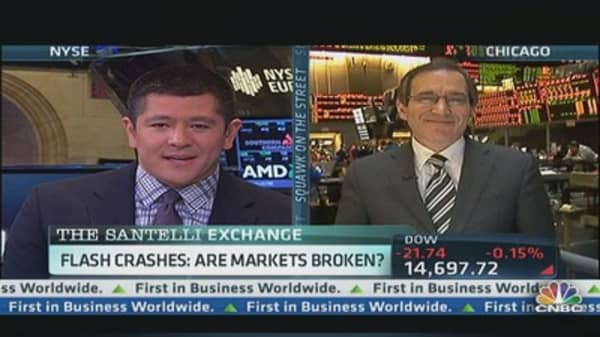The scene was much like the May 6, 2010, "Flash Crash" episode when liquidity evaporated and the Dow cascaded nearly 1,000 points before recovering.
Chatter Tuesday quickly turned to what could be done to stop recurrences where social media apparently can be used to manipulate the market.
(Read More: Markets Plunge Briefly on Fake AP Tweet)
The answer: Probably not much.
"When you have the ability to get a newsworthy event in 140 characters or less and you can instantly move a market, you know what this means. You're going to bring out a lot of people who know they can move a market," said Todd Schoenberger, managing director at LandColt Capital. "How can you regulate it? You really can't regulate it."
Securities Exchange Commission officials were silent Wednesday on any investigations or concern they may have, despite some questioning whether the fake tweeter broke any laws.
"The Hack Attack demonstrates the perilous position in which we find ourselves with social media and technology," Bart Chilton, a commissioner at the Commodity Futures Trading Commission, said in a commentary for CNBC. "It also may well have been illegal."
In fact, the SEC recently caused a stir when it said companies now can disseminate news on social media so long as shareholders are properly apprised.
(Read More: Relax! New SEC Social Media Ruling Is a Good Thing)
As for the traders directly affected, they likely won't be getting any relief.
A New York Stock Exchange source who spoke on condition of anonymity said it's likely no trades will be canceled.
Stopping any future incidents likely could be achieved only by slowing down the high-frequency traders who dominate the market now and respond to the type of news plants that occurred Tuesday.
HFTs run on computer programs tied to algorithms, some of which in turn are hooked into news feeds that use social media postings for information.
"They provide liquidity while times are good, and when times are bad they're not required to provide that liquidity," Stoltmann said of HFTs. "They're the barnacles on the wheels of progress, and I would like to see them eliminated."
In addition to stirring the pot further about high-frequency trading, there also likely will be more talk about the reliance of Twitter and other vehicles to drive trades.
(Read More: One of SEC's Best Weapons May Be in Jeopardy)
The microblogging site has become indispensable to financial journalists and market pros alike in following trends, but could lose some of its cachet.
"There's nothing new about market rumors," said Nicholas Colas, chief market strategist at ConvergEx. "The fact that rumors are distributed through the same mechanism that Justin Bieber uses to communicate with his fans does seem to diminish the seriousness of capital markets. I get that."
Colas found it odd that HFT algos would be kicked in from a single-source report. He said most programs are written with safeguards to confirm reports with multiple sources.
In this case, that may not have happened, and some traders, along with the market's credibility, suffered.
"At the end of the day this is nothing new. The mechanism is new," Colas said. "The mechanism doesn't seem like it's something that should be seriously used as a one-stop shop for investment decisions. Whoever did that paid the price, because it was a really stupid trade."





